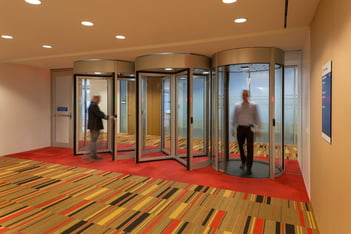The problem with some employees is that they are too nice. They let people in behind them without thinking about it. Most of us are not raised to close a door in someone’s face, so we hold a door open for them, or we let them in behind us, especially if they have forgotten their credentials at home. Good manners, right? Yes, but not good security.
All of which leads an enterprise to find several solutions to secure an entrance: locks on doors or gates, access control systems to control electronic door locks, security officers posted at key locations and security cameras to monitor access.
Mitigating Risk with Security Entrances
Yet, each of those methods have weaknesses that limit your ability to mitigate risk and effectively secure your entrances. An access control system can manage who can open a door, but once it is open, anyone can freely enter or exit. Adding security cameras doesn’t necessarily ensure security; it often just makes it possible to replay what happened after the fact. Employing security officers is expensive, and they may have a limited impact as they can be distracted, misled or overwhelmed.
Security entrance solutions provide the most effective way to allow passage of authorized people, while serving as a deterrent or actual blockage for unauthorized people. Even more, security entrances can provide enterprises with valuable metrics to determine traffic flow, tailgating statistics, biometrics, and more.
You can think of security entrances in terms of four groupings to achieve an array of risk mitigation strategies: crowd control, deterrence, detection, and prevention.
Crowd Control
Security Level 1 entrances such as waist-high turnstiles can count the number of people exiting or entering a facility, helping staffed entrances to cope with large numbers of authorized people who have to enter or leave a secured area in a short time frame. Level 1 systems are designed to slow down and organize entry while also being visual deterrents to potential infiltrators and preserving a relatively open appearance for authorized people. Typical applications include sports stadium entries, factory shift changes, transit terminals, and high-occupancy, and high rise buildings.
Deterrence
Security Level 2 security entrances increase the deterrent factor and incorporate a full height barrier that deters casual attempts to defeat by climbing or crawling. A full height barrier is often deployed at a perimeter fence line as a first layer of physical security, or an “exit only” to allow people to leave but deter them from entering. Here, when integrated with an access control system, metrics such as the number of inbound and/or outbound people in addition to credentials can be tracked.
Detection
Level 3 security entrances employ sensor technology to accurately detect objects moving through an opening, and can determine whether one or two people are passing. In this way, they can detect when tailgating or piggybacking occurs, and sound an alarm when it is detected. They also present a visual deterrent to casual infiltration, and provide a mechanism for integrating with access control systems and credentials. Here, optical turnstiles, which are particularly popular in corporate lobbies, can be equipped with presence detection sensors, and can provide accurate metrics including the number of authorized personnel inbound and outbound, and the number of tailgating incidents or alarms. Certain models equipped with dense sensor arrays can be set up to alarm and count jumping or crawling attempts.
Prevention
Level 4 introduces true tailgating and piggybacking prevention for higher-security facilities and for locations where security staffing is impractical. These security entrances not only serve as a visual deterrent, but also physically deny all forms of unauthorized entry – including tailgating and piggybacking – completely. They incorporate full height barriers to prevent crawling under and climbing over, as well as sensors to ensure that only one person passes through at a time. By integrating facial recognition analytics, it is possible to ensure that the person traveling through the entrance matches the credentials which have been presented. Biometrics serve the same function by utilizing the individual’s face, iris or fingerprint as their credentials.
With the integration of sophisticated near-infrared sensors and optic technologies, such as the StereoVision 2®, these entrances can provide a rich assortment of metrics, including authorization received, passage completed, tailgating/piggybacking rejections inbound or outbound, biometric access control rejections, safety rejections, and emergency button rejections. They can also detect and alert for a range of events such as object left behind.
Securing an entrance can take many forms, but the overall goal is to establish risk mitigation strategies to keep unauthorized entry at bay. Security entrance solutions are the answer for protecting an enterprise while providing critical metrics to further reduce risk. Ultimately, security entrances are a good investment for any organization that needs to control access to any points in their facilities.





